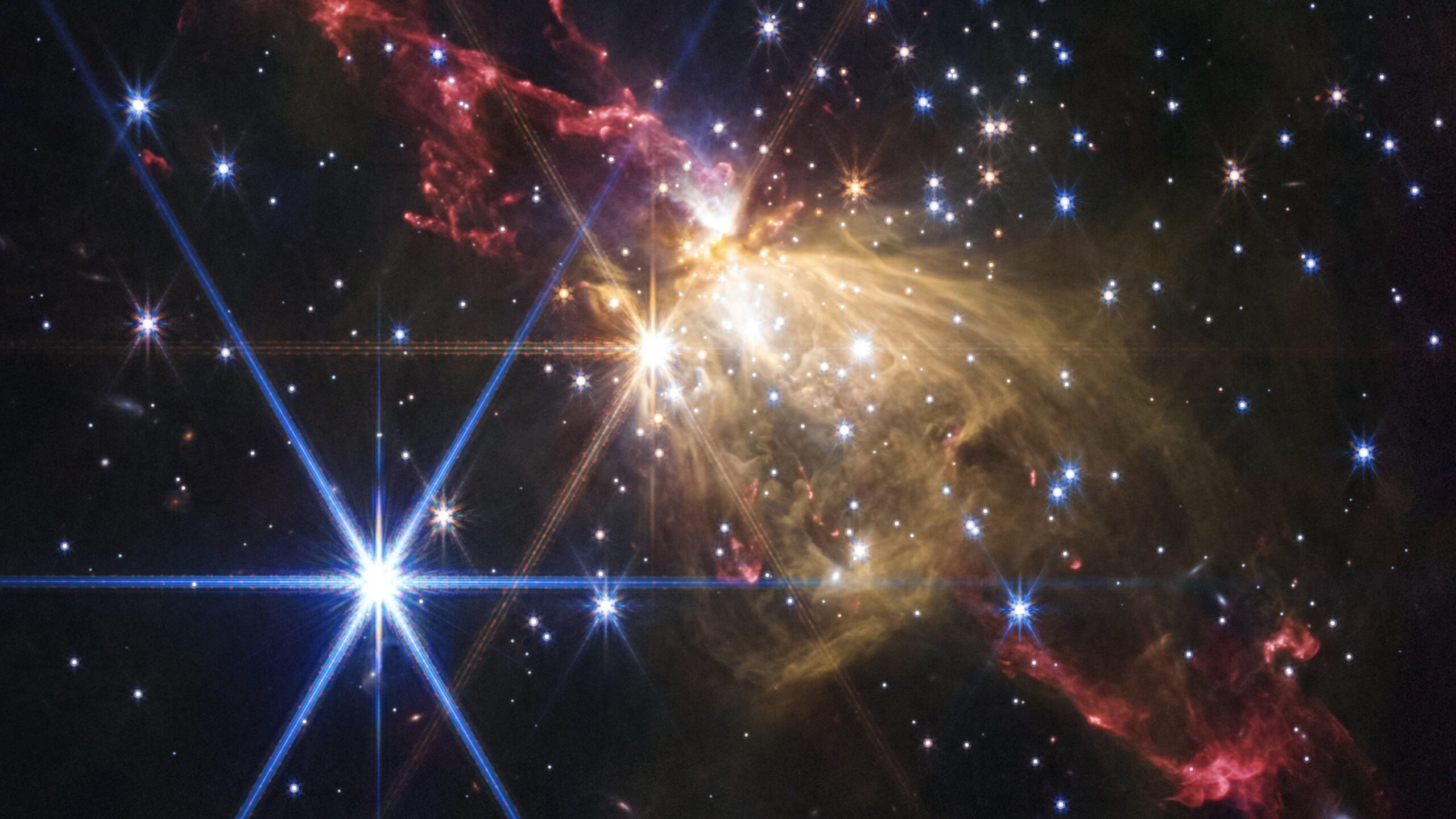Science
Giant Star S284p1 Unveils Rare Jets in Stunning Webb Telescope Image

A newly captured image from the James Webb Space Telescope reveals a remarkable phenomenon: a massive young star, designated S284p1, is ejecting two jets of hot gas at extraordinary speeds, reaching hundreds of thousands of miles per hour. Located approximately 15,000 light-years from Earth, this star is about ten times more massive than our sun and is still in its growth phase.
The jets emitted by S284p1 extend roughly 8 light-years across, which is twice the distance from the sun to the nearest star system. This finding, a collaboration between NASA and its European and Canadian partners, sheds light on the formation processes of giant stars in the universe.
Unprecedented Observations
While astronomers have previously observed many protostellar jets, most of these emissions originate from smaller stars. The presence of such large jets from a giant star like S284p1 is unprecedented, indicating a potential correlation between the size of the star and the scale of its jets. Researchers suggest that this discovery offers new insights into how massive stars develop and may provide clues about similar processes that occurred in the early universe.
Lead author Yu Cheng, affiliated with the National Astronomical Observatory of Japan, expressed surprise at the discovery, stating, “We didn’t really know there was a massive star with this kind of super-jet out there before the observation.” He noted that the outflow of molecular hydrogen from S284p1 is a rare occurrence in the galaxy, emphasizing the significance of this observation.
The findings have been accepted for publication in The Astrophysical Journal, which further validates the importance of this research.
Insights into Star Formation
The location of S284p1 adds to the intrigue surrounding this star. It resides in Sharpless 2-284, a region abundant with dense gas clouds and clusters of young stars. Interestingly, this area contains few elements heavier than hydrogen and helium, which typically play a crucial role in star formation by aiding in gas cooling and clumping. The expectation was that giant stars forming in such an environment would do so in a more chaotic manner, but S284p1 defies this assumption.
Co-author Jonathan Tan, associated with both the University of Virginia and Chalmers University of Technology, remarked, “I was really surprised at the order, symmetry, and size of the jet when we first looked at it.” This observation challenges existing theories, which suggest that the absence of heavier elements should lead to a more disordered formation process, potentially happening in bursts rather than through a steady outflow.
Cheng further elaborated on the implications of this discovery, noting that S284p1 could serve as a laboratory for studying cosmic history. “We can use this massive star as a laboratory to study what was going on in earlier cosmic history,” he said, highlighting the star’s potential to inform our understanding of stellar evolution and the dynamics of galaxy formation.
As scientists continue to analyze the data gathered from the James Webb Space Telescope, the implications of S284p1’s jets and formation process may reshape our understanding of how massive stars influence their environments and contribute to the larger narrative of cosmic evolution.
-

 Health3 months ago
Health3 months agoNeurologist Warns Excessive Use of Supplements Can Harm Brain
-

 Health3 months ago
Health3 months agoFiona Phillips’ Husband Shares Heartfelt Update on Her Alzheimer’s Journey
-

 Science1 month ago
Science1 month agoBrian Cox Addresses Claims of Alien Probe in 3I/ATLAS Discovery
-

 Science1 month ago
Science1 month agoNASA Investigates Unusual Comet 3I/ATLAS; New Findings Emerge
-

 Science1 month ago
Science1 month agoScientists Examine 3I/ATLAS: Alien Artifact or Cosmic Oddity?
-

 Science1 month ago
Science1 month agoNASA Investigates Speedy Object 3I/ATLAS, Sparking Speculation
-

 Entertainment5 months ago
Entertainment5 months agoKerry Katona Discusses Future Baby Plans and Brian McFadden’s Wedding
-

 Entertainment4 months ago
Entertainment4 months agoEmmerdale Faces Tension as Dylan and April’s Lives Hang in the Balance
-

 World3 months ago
World3 months agoCole Palmer’s Cryptic Message to Kobbie Mainoo Following Loan Talks
-

 Science1 month ago
Science1 month agoNASA Scientists Explore Origins of 3I/ATLAS, a Fast-Moving Visitor
-

 Entertainment2 months ago
Entertainment2 months agoLewis Cope Addresses Accusations of Dance Training Advantage
-

 Entertainment3 months ago
Entertainment3 months agoMajor Cast Changes at Coronation Street: Exits and Returns in 2025









